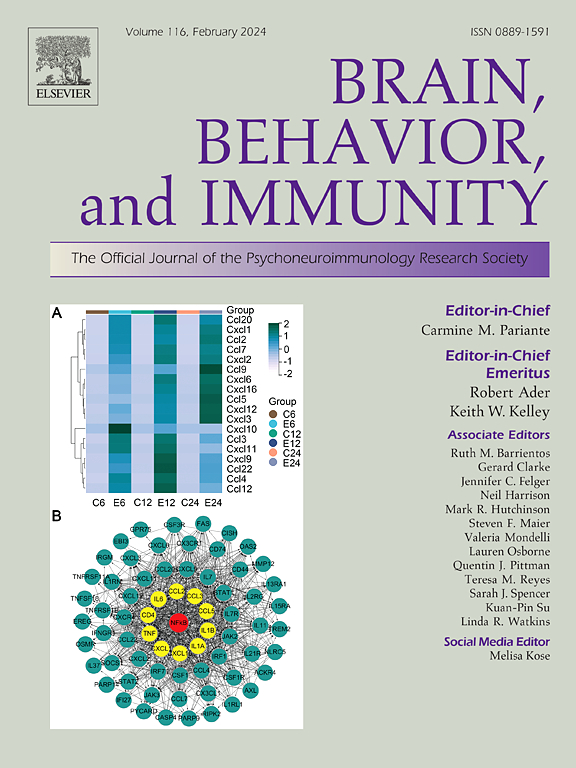老年人步速缓慢的血液生物标志物特征:可解释的机器学习方法
IF 8.8
2区 医学
Q1 IMMUNOLOGY
引用次数: 0
摘要
保持身体功能对老年人独立生活至关重要,而步态速度是预测健康状况的关键因素。血液生物标志物可监测老年人的活动能力,但它们与缓慢步速之间的关系仍有待探索。本研究旨在利用美国中年(MIDUS)研究生物标志物数据集调查血液生物标志物与步速之间的关系。研究采用横断面设计进行分析,涉及 405 名 60 岁及以上的个体。我们使用了机器学习框架,特别是 XGBoost 算法、特征选择方法和 Shapley Additive Explanations,来开发一个可解释的慢步速预测模型。在 35 个变量中,我们的模型在 6 个最重要的特征上获得了最高的交叉验证得分,因为白细胞介素-6、C 反应蛋白、糖化血红蛋白、白细胞介素-8 的升高、年龄增大和女性性别与步速减慢显著相关(曲线下面积 = 0.75)。我们的研究结果表明,血液生物标志物可在评估和监测老年人缓慢步速的综合模型中发挥关键作用。识别关键的血液生物标志物为了解行动能力下降的潜在生理机制提供了有价值的见解,并为早期干预以保护老龄人口的行动能力提供了有希望的途径。本文章由计算机程序翻译,如有差异,请以英文原文为准。
Blood Biomarker Signatures for Slow Gait Speed in Older Adults: An Explainable Machine Learning Approach
Maintaining physical function is crucial for independent living in older adults, with gait speed being a key predictor of health outcomes. Blood biomarkers may potentially monitor older adults’ mobility, yet their association with slow gait speed still needs to be explored. This study aimed to investigate the relationship between blood biomarkers and gait speed using the Midlife in the United States (MIDUS) study biomarker dataset. A cross-sectional design was employed for analysis, involving 405 individuals aged 60 years and over. We used a machine learning framework, specifically the XGBoost algorithm, feature selection methods, and the Shapley Additive Explanations, to develop an explainable prediction model for slow gait speed. Our model demonstrated the highest cross-validation score with the six most important features among 35 variables, as elevated interleukin-6, C-reactive protein, glycosylated hemoglobin, interleukin-8, older age, and female sex were significantly associated with reduced gait speed (area under the curve = 0.75). Our findings suggest that blood biomarkers can play a critical role in integrated models to assess and monitor slow gait speed in older adults. Identifying key blood biomarkers provides valuable insights into the underlying physiological mechanisms of mobility decline and offers promising avenues for early intervention to preserve mobility in the aging population.
求助全文
通过发布文献求助,成功后即可免费获取论文全文。
去求助
来源期刊
CiteScore
29.60
自引率
2.00%
发文量
290
审稿时长
28 days
期刊介绍:
Established in 1987, Brain, Behavior, and Immunity proudly serves as the official journal of the Psychoneuroimmunology Research Society (PNIRS). This pioneering journal is dedicated to publishing peer-reviewed basic, experimental, and clinical studies that explore the intricate interactions among behavioral, neural, endocrine, and immune systems in both humans and animals.
As an international and interdisciplinary platform, Brain, Behavior, and Immunity focuses on original research spanning neuroscience, immunology, integrative physiology, behavioral biology, psychiatry, psychology, and clinical medicine. The journal is inclusive of research conducted at various levels, including molecular, cellular, social, and whole organism perspectives. With a commitment to efficiency, the journal facilitates online submission and review, ensuring timely publication of experimental results. Manuscripts typically undergo peer review and are returned to authors within 30 days of submission. It's worth noting that Brain, Behavior, and Immunity, published eight times a year, does not impose submission fees or page charges, fostering an open and accessible platform for scientific discourse.

 求助内容:
求助内容: 应助结果提醒方式:
应助结果提醒方式:


